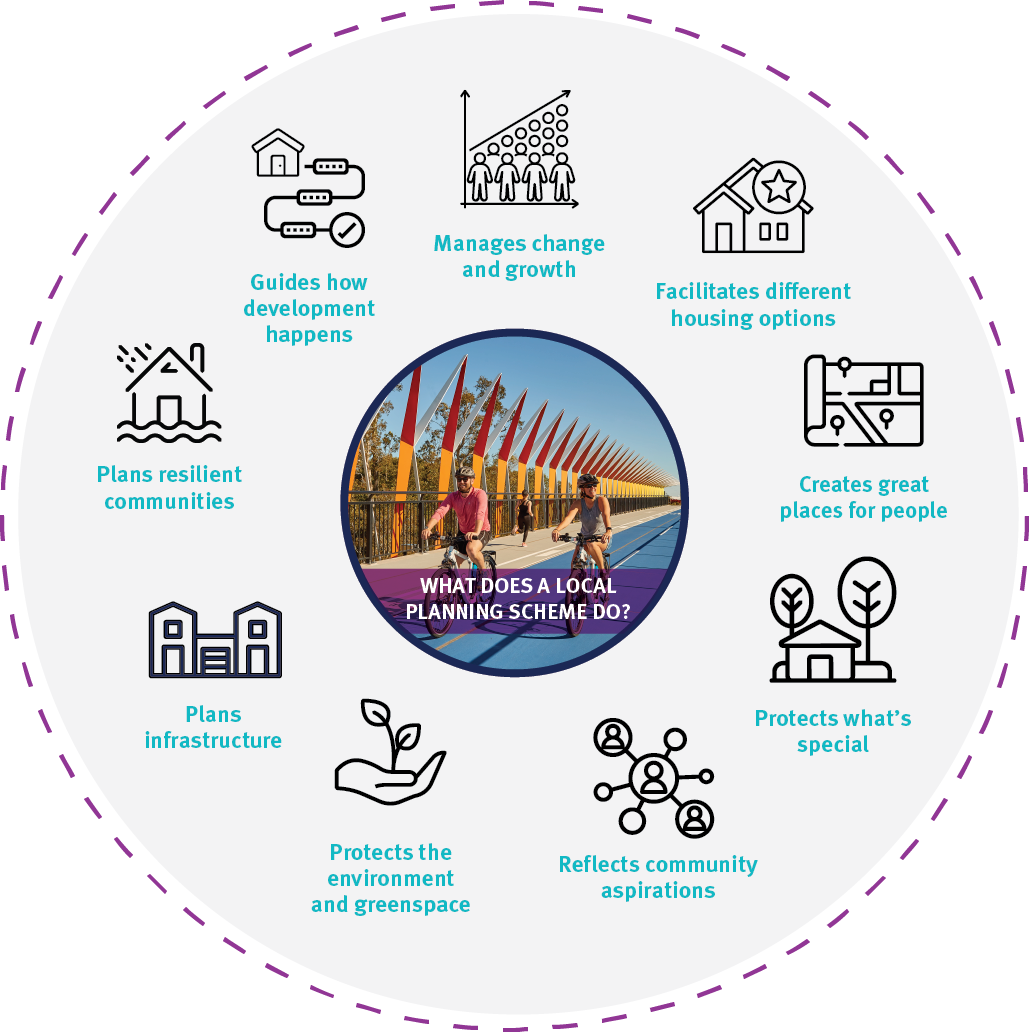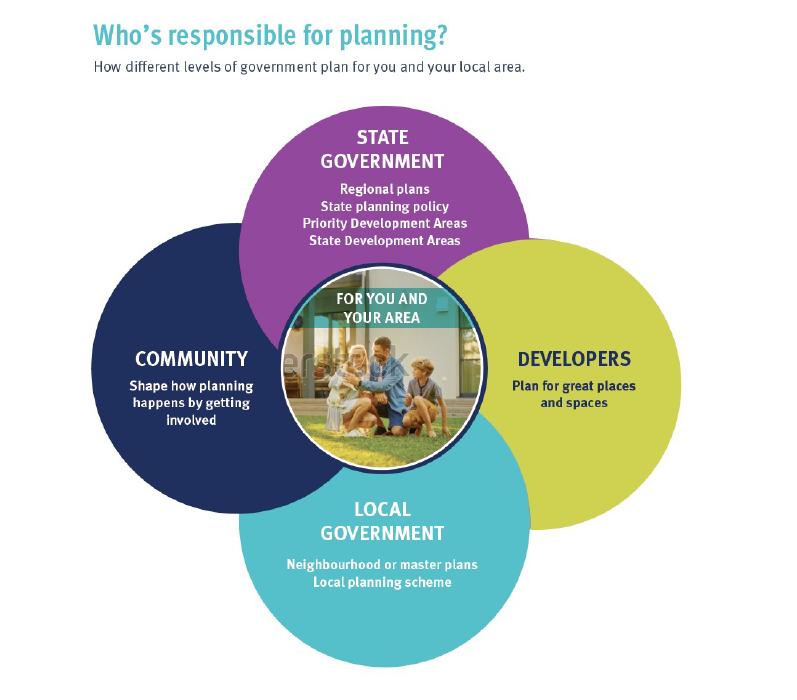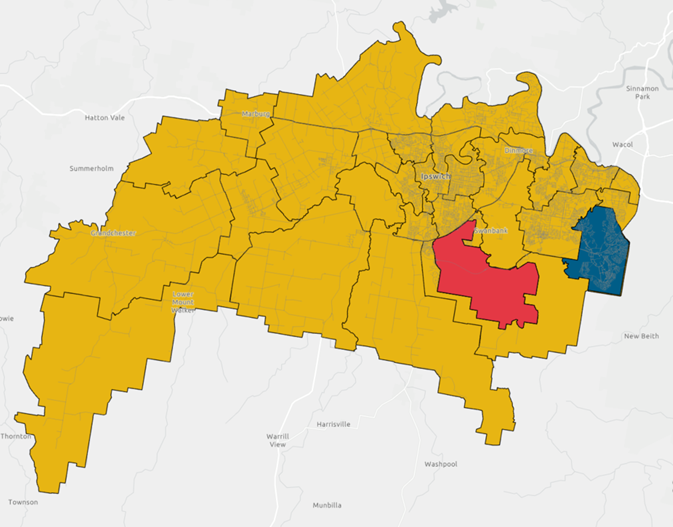Ipswich is one of the fastest growing areas in Queensland and continues to grow and change.
So how do we plan for this growth and change?
Planning is about the right development in the right locations both within Ipswich and South East Queensland, and making it clear what we want to protect and where development should be avoided. In order to meet the challenges for the future, while protecting and maintaining the things our community love about life in Ipswich, we need to plan where, when and how development should occur.
Council has prepared a new planning scheme, Ipswich City Plan 2025, to help us plan for our growing city. The new planning scheme was adopted by Council on 29 May 2025, and took effect on 1 July 2025.
Why plan?
No city stays the same. Cities grow and change to respond to changing people, and opportunities, and respond to challenges.
Our city of Ipswich is a key regional growth area in South East Queensland that is growing and changing at a fast pace. The 2021 population of Ipswich was approximately 247,000 people and is expected to grow to 534,000 by 2046, meaning we need to accommodate an additional 287,000 residents. To manage this growth, we will need to generate at least 75,000 extra jobs and provide for an additional 106,000 homes, including facilitating diversity in lifestyle, housing choice, and affordability.
Planning helps to accommodate this change as Ipswich and the South East Queensland region grows. Planning for the future means understanding what our city is like now, while thinking about what we want for the future. With change, also comes opportunities. Good planning can improve our lifestyle by creating great places for people to live, work and visit.
Planning aims to manage how our city grows and changes in a way that benefits people, places, the environment, and the economy by reconciling a number of often competing interests in the wider public interest. Planning also helps to identify future infrastructure for when and where it’s needed to support sustainable growth.
Change will happen, but it often takes a long time. We therefore need to plan for it so we can manage where it happens and how it affects our community.
What is planning?
Land use planning affects your everyday life. You may not notice it, but planning has shaped the way we live today. Planning influences the places where you live, work and visit, now and into the future.
As our city grows and changes, we need to make sure there is enough land and spaces available in the right locations to support our community’s needs, and plan for enough land for housing, services and business in the areas they are needed, whilst also supporting the local economy and jobs, and protecting what we value for our future.
Planning helps to manage key opportunities and challenges facing our city including:
- Guiding our rapid growth and change
- Facilitating housing and lifestyle choice, diversity and affordability
- Creating great places in which our community can thrive
- Guiding development including managing how land and buildings are used
- Making sure we have the right infrastructure and businesses to support our community, the economy and job growth
- Ensuring our communities become more resilient to natural hazards such as flooding and bushfires, and human-related constraints.
- Protecting our natural environment, green space, natural resources and heritage.
As an example, planning for housing means that we need to plan for a diverse range of housing types and varieties across a range of different locations. This ensures that our communities have the ability to choose from a mixture of places to live and lifestyle options.

Who is responsible for planning?
All levels of government and the private sector play a role in land use planning, infrastructure and services needed to support our community. The state government and local councils primarily share responsibility for land use planning. The property and development industry plan, propose and undertake development to create great places, and communities contribute to shaping their futures by having their say on planning.

Queensland Government
The Queensland Government plans how growth will be managed across the state and regions through various plan-making tools.
State Plan-Making
The state government plans express their key state and regional interests in land-use planning primarily through the State Planning Policy and regional plans.
The State Planning Policy outlines the current state interests which guides how councils should plan for housing, economic growth, the environment, resilience to natural hazards and infrastructure. Local councils need to consider these state’s interest in their planning schemes.
Regional plans set out long-term strategies to guide growth and support future jobs specific to each region’s needs. These plans set job and growth targets while protecting each region’s liveability, natural resources and environment. The state government’s key regional interests encompassing Ipswich are set by the South East Queensland Regional Plan - ShapingSEQ
Priority Development Areas
The state government can also declare priority development areas (PDAs) to promote accelerated development opportunities focused on economic, community and social growth. The Ripley Valley Priority Development Area was declared by the Queensland Government in 2010 to support our city in meeting its growing housing needs.
Legislation
The state government also set the rules for local governments and other users of the planning system to follow through legislation. These planning rules form the process and requirements when making or changing local planning schemes, development assessment and dispute resolution.
To learn more, visit the Queensland Government's planning framework website.
Local Governments
Each local government across Queensland is responsible for the planning of their communities’ future growth and change. This long term vision and direction is set out in the local government’s local planning scheme.
Planning schemes are a legal document that the community, development industry and governments all look to in order to understand their local government’s plan for managing this future growth and change. Planning Schemes are a rule book to help guide the range of development and change that we want to facilitate, protect the features that we want to keep and prevent things we don’t want to see.
Property and Development Industry
The property and development industry can consist of private companies, small developers (including individuals and one-time developers), and not-for-profit groups.
The property and development industry must follow planning requirements and development assessment processes when building on or using their land. Good developments can help us grow sustainably and deliver jobs and growth that are needed for our community.
Local planning schemes outline how your area could grow and change in the future, and the development industry plays an important role in bringing that to life.
Community
The community can play a key role in shaping their future by getting involved and commenting on state, regional and local plans as well as some proposed developments.
The best time for the community to express their views and have a real influence on what should and should not happen in an area, is with the preparation of amendments to our city’s planning scheme. To find out more about or register your interest in future opportunities to comment on council projects in Ipswich, including the development of the Ipswich City Plan 2025, click this link to help Shape Your Ipswich. You can also get the latest from Planning and Development directly by subscribing to eAlerts – here. The community can also make formal submissions to Impact Assessable development applications during their public notification period – here.
What is a planning scheme?
Each local government prepares and maintains its own planning scheme as the main ‘rule-book’ for determining what new developments should occur in their local government area and how. The planning scheme achieves this by planning for and regulating what development should occur where and when, how development should occur and what assessment process is required. Planning schemes help to shape our city by:
- Managing change and growth – Plans for land for housing, infrastructure and business where it is needed and when
- Facilitating different housing options – Encourages a variety of different homes to be built to suit different people
- Guiding how development happens – Provides the framework against which development applications are assessed
- Planning for resilient communities – Maps out natural hazards and human-made constraints including flooding and bushfire overlays to reduce risks to the community
- Creating great places for people – Uses zones and overlay maps to make sure the right activities and buildings go in the right places
- Infrastructure where it is needed – plans for necessary infrastructure needed to support sustainable growth in the right places and infrastructure is built where it is needed in a cost-effective manner
- Protecting the environment and greenspace – Identifies and protects our natural environment, waterways and wildlife
- Protecting what’s special – Protects what’s most important about our city and way of life
- Considering community views and aspirations – formulated with community input
Local government are the main entity responsible for assessing proposed developments triggered by the planning scheme and use the requirements outlined in their planning scheme to assess proposed developments.
Under Queensland planning legislation, a planning scheme cannot prohibit development by stopping a development application from being made, even if the proposed development is not compatible with the requirements of the planning scheme’s intent for the area. The development application must be accepted by council even if there are concerns about its consistency with the planning scheme or the community’s aspirations. This means that almost any development proposal can be put forward to council to be assessed against the provisions of the planning scheme on a case-by-case basis.
Planning schemes are also an evolving document that are continually reviewed to ensure that they respond to the changes in the community and planning circumstances, with a major review generally undertaken every 10 years. Local governments develop planning schemes, including any proposed major changes, in consultation with the community and with the involvement of the state government as the approval authority.
What makes up a planning scheme?
Planning schemes are developed in accordance with planning legislation being the Planning Act 2016 and Planning Regulation 2017, and generally contain consistent elements across Queensland.
The elements of a planning scheme include:
| Strategic framework | Sets out the planning scheme’s overarching policy direction for future development across the city. |
|---|---|
| Zones |
|
| Local area frameworks or plans |
|
| Overlays |
|
| Assessment categories |
|
| Development codes | Development codes include specific assessment benchmarks for types of development, such as ‘reconfiguring of a lot’ applications or specific ‘material changes of use’ proposals (i.e. home based business, tourism, rural activities). |
| Planning Scheme Policies (PSPs) | Planning scheme policies provide information the council may request for a development application and provides guidance or advice about how an applicant can satisfy assessment benchmarks. |
| Local Government Infrastructure Plan (LGIP) | This part outlines the city’s long-term infrastructure planning, which ensures that trunk infrastructure is planned and provided in an efficient and orderly manner. The LGIP integrates land use and infrastructure planning and states the desired standard of service for each trunk infrastructure network. |
The Ipswich City Plan 2025 covers the entire Ipswich local government area, however development within certain areas is governed by legislation and other statutory instruments, such as the declared Ripley Valley Priority Development Area and the area covered by the Springfield Structure Plan.

Ripley Valley
The Ripley Valley was declared a Priority Development Area (PDA) by the state government under the Economic Development Act 2012.
The Ripley Valley PDA Development Scheme is the regulatory document for planning and development within the Ripley Valley PDA, not the Ipswich Plan.
Whilst Ripley Valley was made a PDA by the Minister for Economic Development Queensland, Council is still the assessment manager.
More information on the Ripley Valley PDA is available at, https://www.edq.qld.gov.au/our-work/priority-development-areas-pda/ripley-valley.
Springfield Structure Plan
The Springfield Structure Plan is a Development Control Plan prepared under the now repealed Local Government (Planning & Environment) Act 1990. The plan has remained in effect through a series of transitional provisions in successive Queensland planning legislation, the most recent being the current Planning Act 2016.
The plan was previously included as Part 14 of the 2006 Ipswich Planning Scheme. The Springfield Structure Plan does not form part of the new Ipswich City Plan 2025 and can be accessed separately from Springfield Structure Plan.
How does planning affect you?
Planning influences the places where you live, work and visit, now and into the future.
The planning scheme guides new development on what land can be used for (e.g., apartments, shops and industry) and how land may be developed (e.g., construction of a new building or subdividing land into smaller lots), to help achieve the local government’s intent for managing growth and change across the city.
A planning scheme does not take away existing lawfully established development rights, it can affect changes that may be proposed to those developments. It can also influence what you or others can and can't develop or build on a property. The planning scheme also sets out the rules for development such as building heights, boundary setbacks and carparking requirements.
That’s why it is important to understand what planning controls affect you and where you live, and to get involved to have your say on planning to shape your Ipswich, and importantly your neighbourhood.
More information about development applications within your area can be found by visiting council’s Development.i
To find out what planning controls affect a property or area, check out our online planning scheme mapping
Get involved to shape your Ipswich
There are many ways you can get involved in what is planned for your local area, city or region. By providing your feedback, you are contributing to shaping our city, and helping guide council on decision making and planning for the future.
Want to know more about what’s happening or changing in your local area or region?
To find out more information about development applications in Ipswich and within your area, including making a submission or commenting on an application, visit Development.i
To find out more about or register your interest in future opportunities to comment on council projects in Ipswich, including the development of the Ipswich Plan, click this link to help Shape Your Ipswich.
Get the latest from Planning and Development – subscribe and be notified each time a new alert is issued – here.
You can also go to the Queensland Government’s website to learn more about what the state government is planning for our region, visit haveyoursay.dsdilgp.qld.gov.au
More information
For more information, please contact our friendly planning team by:
- phoning (07) 3810 6666
- emailing council@ipswich.qld.gov.au
- visiting Ground Floor, 1 Nicholas Street, Ipswich
Monday – Friday 8.00 am – 4.30 pm
Access secure undercover parking off Bremer Street.
Directions to Nicholas Street
Ipswich City Council respectfully acknowledges the Traditional Owners, the Jagera, Yuggera and Ugarapul people of the Yugara/Yagara Language Group, as custodians of the land and waters we share. We pay our respects to their Elders past, present and emerging, as the keepers of the traditions, customs, cultures and stories of proud peoples.